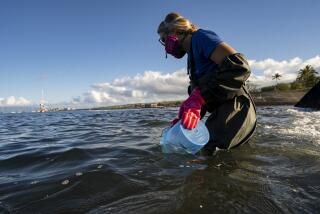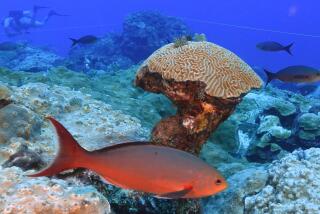Warm-Water Phenomenon : Bleaching of Coral Reefs Puzzles Marine Scientists
- Share via
NEW YORK — On a clear, breezeless day in late July, Bill Causey took one of his fleet of 22-foot powerboats out for a routine inspection of the Florida coral reef marine sanctuary he manages.
The water was unusually warm. The sight was unexpectedly chilling.
“Usually, the coral in the reef is an intense brown, with colorful sea grasses and various algae,” Causey recalled recently.
“But on that day, I saw entire colonies were light and mottled. Some places were solid white.”
Causey, marine biologist and manager of the Looe Key Marine Sanctuary, was one of the first to report on a phenomenon that became increasingly noticeable throughout the Caribbean area as summer faded into autumn.
Loss of Algae
The coral reefs were bleaching--a little understood phenomenon in which the coral sloughs off a type of algae that live within it in symbiotic harmony. Without the algae, the coral eventually dies.
Marine biologists say the bleaching has been observed from Key Largo, Fla., to Cartagena, Colombia, and stretches from the coast of Mexico to Bermuda. Similar events were recorded in 1911, the 1950s, 1966, 1973 and 1985.
But they say this year’s bleaching is by far the worst in the written history of the Atlantic reefs. Some estimate that 10% of the reefs in some areas will be lost.
As disturbing as the loss is, there is little biologists can do but watch and let nature take its course, since it appears that the bleaching has been triggered by unusually warm water temperatures and lighter than normal winds.
Not a Disaster
“There is no reason to play this as a disaster,” said John C. Ogden, director of Fairleigh Dickinson University’s West Indies Laboratory. “There’s really no evidence indicating it’s something more than a natural phenomenon.”
“This is one of these cases where we can say with some certainty that man is not to blame,” Causey said.
Coral reefs are among the breathtaking sights of the undersea world. They can stretch for miles and sink hundreds of feet. They are alive with intricate, flower-like algae, rippling water grasses and lively sea creatures.
“Just the most beautiful sight in the world,” said Causey, an experienced diver who has managed Looe Key for four years.
Basically Hollow
Corals are coelenterates, the same phylum of animals that includes jellyfish and sea anemones. The word is from the Greek, meaning hollow gut, and explains the coral’s simple structure.
Coral polyps grow in finger-like projections of clusters of sacks, each with a single opening through which food is ingested and waste is eliminated.
The great reefs, which usually form barriers to the entrances of island lagoons, or which grow out of stretches of land, are built up over thousands of years. As corals die, their skeletons are left behind. New polyps of corals build on top and attract algae and other sea life.
The soft, living corals also have algae living within their tissues, and that gives them color, according to Peter Glynn, professor of biology at the University of Miami and an expert on reefs.
“Coral feed on animal matter and algae both,” Glynn said. “But they have algae that lives within it in a symbiotic relationship.”
Protected by Coral
The symbiotic algae, zooxanthellae, are protected by the coral and feeds on its waste. In turn, it provides the coral with energy by providing it with amino acids and other building-block materials derived from photosynthesis.
“What’s more, there’s some evidence the algae help the coral to calcify, to lay down the skeleton rapidly so the reef can continue to grow,” Glynn said.
For reasons that are not entirely clear, the coral will shed the zooxanthellae when it is under stress. The coral turns white as the microscopic plant life, which gives it vigor and color, is expelled.
“For a long time there was debate over whether the coral was shedding the algae or if the algae might be leaving on their own,” Glynn said.
Recent research has shown that the coral emits a mucus-like membrane in which the algae become entangled, he said. The coral then sheds this slimy membrane by moving it with tiny hair-like projections called cilia.
“Coral can live between three to five weeks without the algae,” Glynn said. “Then the living tissue sloughs off and only the skeleton remains.
“Some corals do revive and survive these bleachings,” he said. “Algae are able to re-invade. But it has to happen within a certain period of time.”
More to Read
Sign up for Essential California
The most important California stories and recommendations in your inbox every morning.
You may occasionally receive promotional content from the Los Angeles Times.













